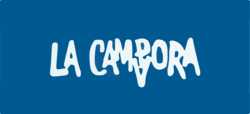La Cámpora
La Cámpora | |
|---|---|
 | |
| Leader | Máximo Kirchner |
| Secretary-General | Andrés Larroque |
| Founder | Andrés Larroque, Máximo Kirchner, Juan Cabandié, Mariano Recalde, |
| Founded | 28 December 2006 |
| Headquarters | Buenos Aires |
| Student wing | La Cámpora Secundarios |
| Youth wing | La Cámpora Universidad |
| Ideology | Peronism Kirchnerism |
| Political position | Left-wing |
| National affiliation | Frente de Todos |
| Slogan | La patria es el otro |
| Website | |
| http://www.lacampora.org/ | |

La Cámpora is an Argentine political youth organization supporting the governments of Néstor Kirchner, Cristina Fernández de Kirchner, and Alberto Fernández. It is named after former Peronist president Héctor José Cámpora. It was established by Máximo Kirchner in 2006 and became politically prominent after the death of former president Néstor Kirchner.
History[]
La Cámpora was created by Máximo Kirchner, son of Néstor Kirchner and Cristina Fernández.[1] Its origins can be traced back to the 2003 Argentine general election, in order to support Néstor Kirchner, and has extended said support to Cristina Fernández de Kirchner during the 2008 Argentine government conflict with the agricultural sector, to counter the opposing demonstrations.[1]
The group vindicates the actions of the guerilla group Montoneros, and thus was named after Héctor José Cámpora, who had favored them.[2] La Cámpora's methodology bears no similarity to Montoneros though, aiming instead to confront the discourse implemented by the political right wing through what it perceives as their dominance of the Argentine media that opposes any and all changes implemented by the Kirchner administration. They use new technologies, including blogs, Facebook, Twitter and other social networks on the internet,[3] La Cámpora confronts the media conglomerates that control the vast majority of Argentine media and work, according to La Cámpora, to undermine the Kirchner administration.[2]
Most of the organization leaders face or faced corruption charges.[4] La Cámpora is also linked to international corruption activity, specially from its ally government of Venezuela.[5]
Initially, the group had the usual low profile of most youth wings. After the death of Néstor Kirchner in 2010, the organization became one of the three factions struggling for power within the Kirchner administration, the others being the General Confederation of Labour and the traditional structure of the Justicialist Party.[6] Cristina Fernández instructed that the lists of candidates for provincial legislators included at least two or three members of the Cámpora among the first eight.[6]
A violent clash broke out between the group's members and those of the construction workers union UOCRA.[7]
See also[]
- Kirchnerism
- Members of La Cámpora
References[]
- ^ a b "La Cámpora gana espacio en el entorno kirchnerista". La Nación (in Spanish). 31 August 2010.
- ^ a b "La Cámpora". La Nación (in Spanish). 27 March 2011.
- ^ "Secretos de la "peronosfera K"" (in Spanish). 22 October 2010.
- ^ "Cuatro jefes de La Cámpora quedaron involucrados por el manejo de fondos negros". Perfil (in Spanish). 2018-08-18. Retrieved 2021-05-09.
- ^ de 2019, 24 de Enero. "Andrés Larroque: "La Cámpora apoya al gobierno de Nicolás Maduro"". infobae (in European Spanish). Retrieved 2021-05-09.
- ^ a b "La Cámpora avanza en las listas del oficialismo de todo el país" (in Spanish). 22 May 2011.
- ^ Tarbuck, Emily. "La Plata Union Demands Release of Members Following Violent Clashes". The Argentina Independent. Retrieved 18 April 2013.
External links[]
| Wikimedia Commons has media related to La Cámpora. |
- Official site (in Spanish)
- Corruption in La Campora. (in Spanish)
- Corruption in La Campora. (in Spanish)
- Justicialist Party
- Presidency of Cristina Fernández de Kirchner
- Youth wings of political parties in Argentina
- Political parties established in 2006
- 2006 establishments in Argentina
- Kirchnerism
